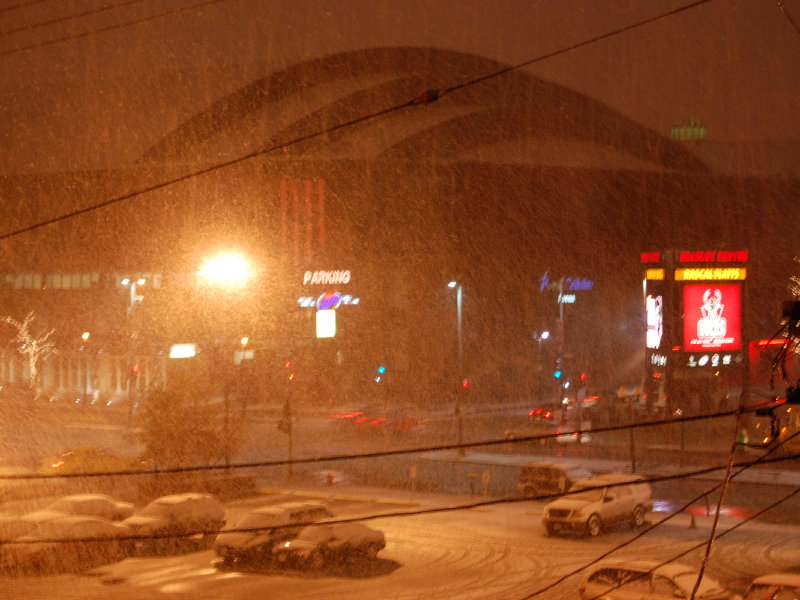Wall-to-wall "storm team coverage."
It's that phrase TV viewers love to hate. We all make fun of those poor reporters, standing in blizzards, and the over-caffeinated meteorologists frothing at the mouth as they show us animated maps depicting deadly snow.
Yet we watch. And watch some more. Which is exactly why Milwaukee's local TV news producers spoon-feed us hours upon hours of late-breaking storm coverage, even if only a few flakes ultimately land on the ground.
But, if it makes you feel better, even veteran meteorologists think that sometimes TV news goes too far. However, two former forecasters admit that weather is, first and foremost, a business.
"You assume that a station is always speaking with one voice," says Craig Koplien, who worked as a meteorologist at WMTJ-4 TV until this fall. "It's actually multiple voices ... that have been tinged by the way they've been directed to write about the weather by news management."
Lance Hill, who was a meteorologist at WISN-12 for 10 years, says he understands why local news places a high priority on winter storms.
"It's not overblown, in that people tune in to watch it," says Hill. "If it was, people wouldn't watch it. (For) the kind of storm that keeps people home from work, viewership is higher. But people do watch because snow can really impact everyone and their daily routine."
In other words, TV weather is about news, but it's perhaps more about ratings.
"The answer to all your questions is money, and weather gets big viewership, whether bad weather is in progress or bad weather is forecasted. There's no question about it. It's a proven fact," says Koplien.
Says Hill, "There's so much pressure to be No. 1 that news departments feel like they can use these opportunities to stand out and differentiate from everyone else. They realize that if people can trust you for great weather coverage, it's likely that they will turn to you for significant news coverage, as well."
But now that he's out of the business, does Koplien think severe weather is overhyped?
"There are some people who overhype it, and there are other people who present weather with the right tone that's appropriate," says Koplien. "Yes, it does bother me when a situation that I don't deem hype-worthy gets overhyped. Granted, what's a 'hype-worthy' storm is a little subjective, but you have to measure that against who are your viewers."
Those viewers, at least in Wisconsin, should know what to do when it snows a little, right?
"Absolutely," says Koplien. "You can still slide off the road and into a ditch in two inches of snow, but in the big picture, are there four accidents like that or 400?
"Milwaukee can handle four-inch snow falls without me having to scream the sky is falling. It hurts the credibility of the profession of meteorology, and I also think it hurts the credibility of the TV station."
Hill agrees. "Two inches, yeah, absolutely Wisconsinites can handle that."
But he points out that seasonality has an effect on how news covers storms. Stations are likely to go wall-to-wall storm team for the first blizzard of the year, but by January or February, snowfalls become less newsworthy.
"It takes a much bigger, more powerful snowstorm for a news department to pull out all the stops. Also, the timing -- if it will impact rush hour -- makes a difference, as well," says Hill.
Koplien, who began his meteorology career in 1990 in Madison, says the industry has definitely changed since then.
"At my first job, I don't remember news managers entering the weather center almost ever, and certainly not as much as they do now, to find out what the weather situation is going to be, in an attempt to figure out how high to play up the weather in a newscast. The weather was rarely the lead story.
"Nowadays, the weather is leading the news, what, half the nights each week?"
"Weather has become more of a coveted commodity," says Hill.
Koplien says he doesn't object to the amount or length of the weather coverage during an actual storm, though. "You're not obligated to watch," he says. "My problem is if there's two inches of snow on the ground, and the tone of the anchors is 'this is the end of the world'."
"If you're not there and your competitor is," says Hill, "that's a strike against you."
Andy is the president, publisher and founder of OnMilwaukee. He returned to Milwaukee in 1996 after living on the East Coast for nine years, where he wrote for The Dallas Morning News Washington Bureau and worked in the White House Office of Communications. He was also Associate Editor of The GW Hatchet, his college newspaper at The George Washington University.
Before launching OnMilwaukee.com in 1998 at age 23, he worked in public relations for two Milwaukee firms, most of the time daydreaming about starting his own publication.
Hobbies include running when he finds the time, fixing the rust on his '75 MGB, mowing the lawn at his cottage in the Northwoods, and making an annual pilgrimage to Phoenix for Brewers Spring Training.






